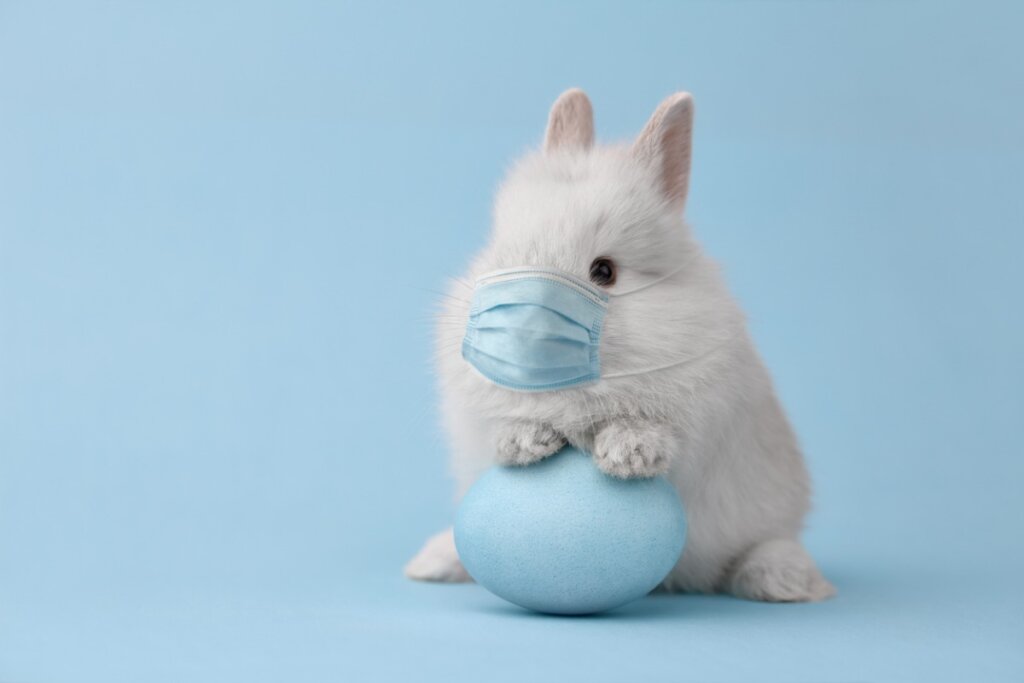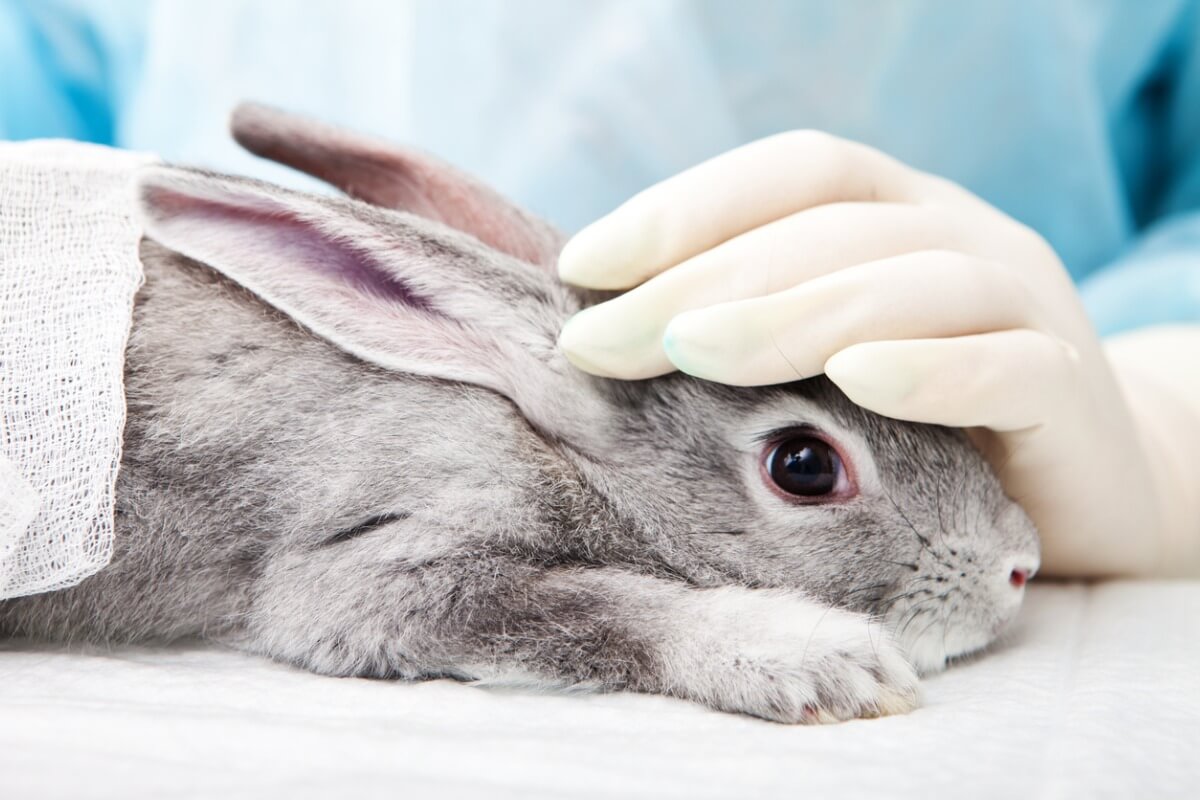Encephalitozoonosis in Rabbits

There are many rare diseases that pet owners are hardly aware of, either because of their low prevalence or because of the complex terminology needed to understand the medical condition. The latter is exemplified by encephalitozoonosis in rabbits, a typical condition in these animals, caused by the pathogen Encephalitozoon cuniculi.
This obligate parasite can appear in the rabbit’s body silently or symptomatically. The mortality rate is much higher among rabbits (up to 12,3 %) than in adults, but it’s a very difficult disease to treat in all cases. Read on if you want to find out more about it.
What is encephalitozoonosis in rabbits?
Encephalitozoonosis in rabbits is an infectious, chronic, systemic disease caused by the microorganism Encephalitozoon cuniculi. This is a microsporidium, which means that it’s part of a group of unicellular parasites that have the ability to form spores. E. cuniculi needs to enter the cells of its host to survive, as it lacks mitochondria, peroxisomes, and other vital structures.
The main host of this parasite is the rabbit, but it can also affect rats, hamsters, dogs, cats, guinea pigs, and humans. This means that the disease is zoonotic (capable of infecting our species). Immunocompromised people with a diagnosed disease are particularly vulnerable.
It’s estimated that up to 100% of rabbit farms have rabbits with circulating antibodies to the micro-organism, which means that that they have, or have had, the disease.

The life cycle of Encephalitozoon cuniculi and contagion
The biologically active form of the parasite doesn’t only live inside the rabbit’s cells, but also generates spores that are very resistant to environmental conditions. It’s a crescent-shaped micro-organism and resembles Toxoplasma gondii, the causative agent of toxoplasmosis.
Now that you know this information, we’ll tell you all about the life cycle of the parasite that causes the disease:
- Most rabbits become infected by ingesting food contaminated with the spores of the parasite. The lactation phase is one of the most dangerous periods of contagion as the rabbits are in close contact with the mother and her urine (which may or may not be sick).
- Spores that aren’t ingested can remain viable at room temperature in the soil for up to 4 weeks.
- The spores that are ingested orally travel through the digestive system of the rabbit until they come into contact with the intestinal mucosa. There they’re introduced into the enterocytes, the special cells of this section of tissue. In them, the microorganism multiplies and forms a parasitophorous vacuole which, when broken, releases many pathogens and kills the host cell.
- Once it has multiplied, the parasite enters the lymphoid tissue and is distributed throughout the body by traveling in special cell bodies.
- Parasites usually settle in the nervous system and kidneys. New spores are released with the urine of the infected animal, thus restarting the cycle.
As you can see, the immense majority of contagions occur when a healthy rabbit comes into contact with the urine of another sick rabbit and eats the spores involuntarily. In any case, professional sources also tell us that a mother can infect the young rabbits before they’re born through the uterine route.
Symptoms caused by Encephalitozoon cuniculi
Most rabbits infected with Encephalitozoon cuniculi don’t show clinical signs until they’re old, become infected with another disease simultaneously, suffer stress, or suffer from immunosuppression. There may be infected animals that have no external symptoms, but internal lesions are always seen when dissected after death.
Rabbits with encephalitozoonosis show a wide range of clinical signs, including the following:
- Very whitish cataracts in one or both eyes
- Head tilting (vestibular syndrome) due to nervous system involvement
- Involuntary and erratic movement of the eyes (nystagmus)
- Anorexia and weight loss
- Locomotor problems and loss of balance
- Tremors and convulsive seizures
- Hypersensitivity to light
If the rabbit’s kidneys end up being damaged by the action of the parasite, it’ll have a series of very unspecific symptoms which can be confused with other diseases. For this reason, you’ll need to go and see a vet at the slightest sign of illness.
Diagnosis
The vet will try to make a preventive diagnosis by observing the medical symptoms of the affected animal. Unfortunately, the external symptoms are very similar to those caused by other parasitic conditions (such as toxoplasmosis) and a full differential criterion can’t be established until the animal has already died.
The unequivocal method of detecting the disease is serology, i.e. to see if antibodies to the pathogen are present in the animal’s blood. However, a positive result only indicates that E. cuniculi has used the animal as a host at some point, but not that the infection is active. Additional neurological tests are therefore required.
Treatment
There’s currently no standardized treatment for the Encephalitozoon cuniculi infection. The veterinarian can try a wide range of drugs and remove ocular cataracts (if present), but there’s no guarantee that the disease will be completely cured.
The best treatment to prevent the spread of this condition in the rabbit population is to isolate the sick animal and sanitize as much as possible any surface it may have urinated on. If the symptoms are too aggressive and the animal is suffering excessively, then euthanasia is usually the only way out.
Albendazole is a drug that seems to eliminate the infection to some extent. Unfortunately, the destruction of the spores and parasites doesn’t always result in symptomatic improvement, as the damage has already been done.

Can I be infected by Encephalitozoon cuniculi?
We’ve said that encephalitozoonosis in rabbits is a zoonotic disease that can be transmitted to humans. This is true, but very few cases have been detected to date and almost all occur in very young, very old, or immunocompromised people. It’s especially common in AIDS patients and those who have received a recent transplant.
In any case, we recommend that you handle your rabbits with the utmost caution if an outbreak of encephalitozoonosis has been detected. Always wear gloves (and a mask if possible), wash your hands, and seek veterinary attention so that they can show you what you need to do.
All cited sources were thoroughly reviewed by our team to ensure their quality, reliability, currency, and validity. The bibliography of this article was considered reliable and of academic or scientific accuracy.
- Encefalitozoonosis en conejos, Sanidad y Seguridad. Recogido a 1 de octubre en https://asescu.com/wp-content/uploads/2017/02/182SanidadBioseguridad2.pdf
- Encephalitozoonosis in rabbits, VCA Hospitals. Recogido a 1 de octubre en https://vcahospitals.com/know-your-pet/encephalitozoonosis-in-rabbits
